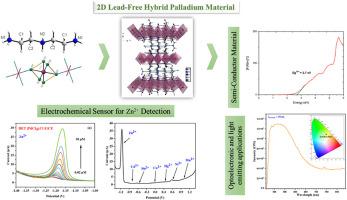Structural, optical, and electrochemical performance of a novel lead-free Pd(II) perovskite for Zn2+ detection
IF 3.5
3区 化学
Q2 CHEMISTRY, INORGANIC & NUCLEAR
引用次数: 0
Abstract
A novel two-dimensional lead-free Pd (II)-based perovskite, (C4H16N3)[PdCl4]Cl (abbreviated DET[PdCl4]Cl), was successfully synthesized via slow evaporation at room temperature. Single-crystal X-ray diffraction analysis indicates that it crystallizes in the orthorhombic Pnma space group, forming a 2D layered structure comprising corner-sharing [PdCl6] octahedra interconnected through organic diethylenetriammonium cations. The structure is stabilized through numerous N–H⋯Cl hydrogen bonds, which lead to a robust three-dimensional network. Infrared spectroscopy reveals the presence of functional groups as well as hydrogen bonding associations. At the same time, UV–Vis diffuse reflectance spectroscopy reveals three absorption bands and a direct optical bandgap of 2.7 eV, confirming the material's semiconductor nature. Photoluminescence studies show a strong emission peak at 530 nm, with CIE chromaticity coordinates (0.3648, 0.5026), indicating potential for optoelectronic and light-emitting applications. Thermal analysis (TGA-DTA) demonstrates high thermal stability up to 280 °C with three distinct decomposition stages and endothermic peaks associated with structural transitions. Electrochemical tests show that DET [PdCl4]Cl-modified glassy carbon electrodes (GCEs) improve electron transfer and electrochemical performance. The sensor displays high sensitivity and selectivity for Zn2+ detection, with a low detection limit of 2 × 10−8 M and a linear range up to 1 × 10−5 M. It offers good stability and reproducibility, with a relative standard deviation of 1.51 %. Tests on real water samples show recovery rates between 97 % and 102 %, confirming the sensor's accuracy for environmental monitoring. Overall, DET [PdCl4]Cl shows great potential for use in optoelectronic devices and heavy metal detection due to its thermal stability, semiconductor properties, and strong electrochemical performance.

用于Zn2+检测的新型无铅Pd(II)钙钛矿的结构、光学和电化学性能
采用室温慢蒸发法制备了一种新型二维无铅Pd (II)基钙钛矿(C4H16N3)[PdCl4]Cl(缩写为DET[PdCl4]Cl)。单晶x射线衍射分析表明,它在正交pma空间群中结晶,形成由有机二乙基三铵离子相互连接的共角[PdCl6]八面体组成的二维层状结构。该结构通过许多N-H⋯Cl氢键稳定,从而形成坚固的三维网络。红外光谱显示了官能团和氢键的存在。同时,紫外-可见漫反射光谱显示了三个吸收带和2.7 eV的直接光学带隙,证实了材料的半导体性质。光致发光研究表明,在530 nm处有很强的发射峰,具有CIE色度坐标(0.3648,0.5026),表明了光电和发光应用的潜力。热分析(TGA-DTA)表明,高达280°C的高热稳定性具有三个不同的分解阶段和与结构转变相关的吸热峰。电化学试验表明,DET [PdCl4] cl修饰的玻碳电极(GCEs)改善了电子传递和电化学性能。该传感器对Zn2+检测具有较高的灵敏度和选择性,检测限为2 × 10−8 M,线性范围可达1 × 10−5 M,具有良好的稳定性和重复性,相对标准偏差为1.51%。对实际水样的测试表明,该传感器的回收率在97% ~ 102%之间,证实了该传感器用于环境监测的准确性。总的来说,DET [PdCl4]Cl由于其热稳定性、半导体性质和强大的电化学性能,在光电器件和重金属检测中显示出巨大的应用潜力。
本文章由计算机程序翻译,如有差异,请以英文原文为准。
求助全文
约1分钟内获得全文
求助全文
来源期刊

Journal of Solid State Chemistry
化学-无机化学与核化学
CiteScore
6.00
自引率
9.10%
发文量
848
审稿时长
25 days
期刊介绍:
Covering major developments in the field of solid state chemistry and related areas such as ceramics and amorphous materials, the Journal of Solid State Chemistry features studies of chemical, structural, thermodynamic, electronic, magnetic, and optical properties and processes in solids.
 求助内容:
求助内容: 应助结果提醒方式:
应助结果提醒方式:


